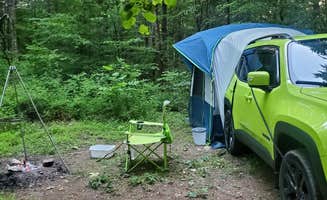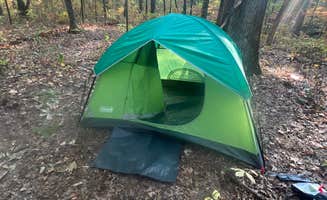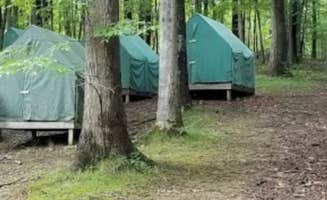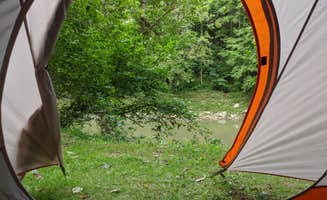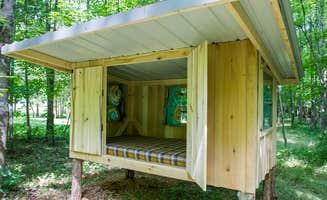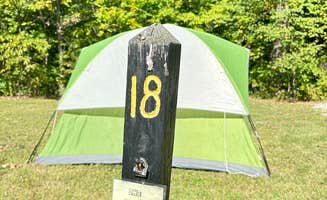Dispersed camping near Brownstown, Indiana centers around the Hoosier National Forest, with most free campsites located within 20 miles of town. The forest spans approximately 203,000 acres with elevations ranging from 450 to 900 feet above sea level. Seasonal limitations occur during winter months when unpaved access roads can become challenging after rainfall, sometimes requiring higher clearance vehicles.
What to do
Explore geodes and caves: The Patton Cave trail in Charles C. Deam Wilderness offers unique geological features. "I walked the creek for hours just looking at all the rocks on the sandbars. I have never encountered so many geodes in my life. Truly magnificent to encounter," notes Sarah R. The cave itself is described as "amazing" with abundant backwoods camping spaces along the trail.
Visit Monroe Lake: Several dispersed camping areas provide access to this 10,750-acre reservoir for fishing and swimming. "We enjoyed the sycamore loop, which was around 6 miles. Everyone is super kind in the area, except for the gravel road to park (which is limited)," shares Hannah F. about trails that connect to the lake.
Search for morels: Spring visitors can hunt for prized morel mushrooms in the forest. "We visited during mid-April, perfect for finding morels. The trails are well paved and marked, not too strenuous," notes a Charles C. Deam Wilderness camper. The forest floor provides ideal conditions for mushroom hunting from late March through early May.
What campers like
Privacy between sites: Berry Ridge Road Dispersed Camping offers exceptional separation between campsites. "Multiple campsites in the area, I've stayed at two both of which were away from others, clean, fairly flat and had plenty of dead wood around to burn," explains Jeremy F. This spacing provides a more authentic wilderness experience compared to standard campgrounds.
Wildlife observation: Night sounds and animal sightings enhance the camping experience. "Just trees knocking, bugs curling and frogs croaking. Did see a rattlesnake dead on the road," reports Ax H. about Berry Ridge Road. Another camper, Reuben R., mentions, "every night at around 5pm I would hear rustling in the leaves, I assumed it was a pack of cayotes."
Trail access: Many sites offer direct connections to hiking paths. "There are a couple walking trails around, as well each site is fairly far apart," notes Ozzie L. about Berry Ridge Road Dispersed Camping. The area provides both short walks and connections to longer trail networks throughout the forest.
What you should know
Road conditions matter: Access to most dispersed sites requires travel on gravel roads that can deteriorate after rain. "The road was gravel and steep at times," reports Amber R. about Berry Ridge Road Dispersed Camping. Another camper advises, "I would not bring a Rv here especially after rain."
Water sources are limited: Plan to carry all necessary water. A Charles C. Deam Wilderness camper warns, "Refill your water when you come across it; the lake is harder to get to than you think." Most dispersed sites have no water facilities, requiring complete self-sufficiency.
Variable site conditions: Campsite quality and accessibility can change throughout the year. "Some sites, at least one, could fit a pretty good sized camper. This is pack in pack out, no amenities camping for free," notes Jeremy F. Another camper explains that "once on trail I didn't see another soul past a couple hundred feet of the trail head."
Tips for camping with families
Tree activities: Happy Hollow Homestead features unique aerial attractions for children. "The tree web is a giant net about 15 feet in the air. My boys loved climbing up and laying in the web. The tire swing was also fun for the kids," shares Heather K. These activities provide entertainment without electronic devices.
Short hiking options: Several camping areas offer child-friendly walking trails under 1 mile. "There is a paved bicycle trail approximately 5 miles long one way," notes Ron H. about Morgan-Monroe State Forest, which also offers shorter nature paths suitable for younger hikers.
Playground access: Some established campgrounds include play equipment. "There is a playground and fire tower right next to the Mason Ridge campground," mentions Daisy C. about Morgan-Monroe State Forest, providing an alternative activity when children need a break from hiking.
Tips for RVers
Size restrictions: Most dispersed camping areas near Brownstown accommodate only smaller RVs and trailers. "Our Boy Scout troop enjoyed visiting this location. It was well maintained and the staff was helpful," shares Na J. about Ransburg Scout Reservation, which can accommodate modest-sized RVs but notes "aquatics area was hard to get to from our site because it was so far away."
Limited RV amenities: Even established campgrounds offer minimal hookups. "We are RV campers and there are only about 5 sites we could get in to. Our camper is about 25' and it was tight get in and out of the campground," explains Ron H. about Morgan-Monroe State Forest. Another camper mentioned, "there is a dump station, but I barely got in to dump."
Generator considerations: Tent camping near Brownstown, Indiana typically restricts generator use to preserve the wilderness atmosphere. "We had a generator that we used sparklingly," notes Don N. who camped in a "Winnebago Micro Minnie 2108 TB" at Morgan-Monroe, adding that "This park is not for large rigs."


